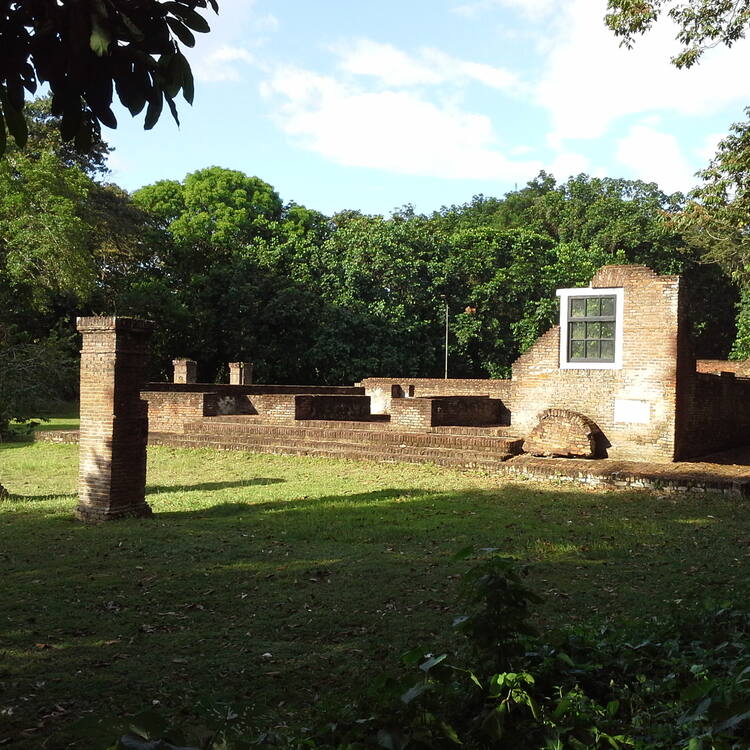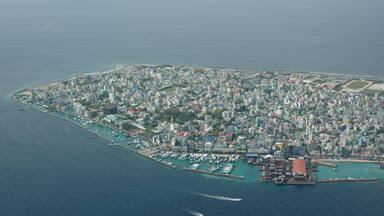Jodensavanne Archaeological Site: Jodensavanne Settlement and Cassipora Creek Cemetery
Jodensavanne Archaeological Site: Jodensavanne Settlement and Cassipora Creek Cemetery
Located on high ground on the densely forested banks of the Suriname River, the Jodensavanne Archaeological Site in northern Suriname is a serial property that illustrates early Jewish colonization attempts in the New World. The Jodensavanne Settlement, founded in the 1680s, includes the ruins of what is believed to be the earliest synagogue of architectural significance in the Americas, along with cemeteries, boat landing areas, and a military post. The Cassipora Creek Cemetery is the remnant of an older settlement founded in the 1650s. Located amidst Indigenous territory, the settlements were inhabited, owned, and governed by Jews who lived there together with free and enslaved persons of African and Indigenous descent. The settlements had the most extensive arrangement of privileges and immunities known in the early modern Jewish world.Description is available under license CC-BY-SA IGO 3.0
Site archéologique de Jodensavanne : établissement de Jodensavanne et cimetière de Cassipora Creek
Situé en hauteur sur les rives densément boisées du fleuve Suriname, le site archéologique de Jodensavanne, dans le nord du Suriname, est un bien en série qui témoigne des premières tentatives de colonisation juive dans le Nouveau Monde. L’établissement de Jodensavanne, fondé dans les années 1680, comprend les ruines de ce que l’on pense être la plus ancienne synagogue des Amériques revêtant une importance architecturale, ainsi que des cimetières, des débarcadères et un poste militaire. Le cimetière de Cassipora Creek constitue le vestige d’un établissement plus ancien, fondé dans les années 1650. Situées en territoire autochtone, ces colonies étaient habitées, possédées et dirigées par des Juifs qui y vivaient avec des personnes d’origine africaine et autochtone, libres ou esclaves. Ces établissements bénéficiaient du plus large éventail de privilèges et d’immunités connu dans le monde juif des débuts de l’époque moderne.
Description is available under license CC-BY-SA IGO 3.0
موقع جودن سافان الأثري: مستوطنة جودن سافان ومقبرة جدول كاسيبورا
موقع جودن سافان الأثري عبارة عن عنصر متسلسل يقع في شمال سورينام على ضفتَي نهر سورينام التي تتسم بكثافة حرجية، وهو يبين محاولات الاستعمار اليهودية المبكرة في العالم الجديد. وتأسست مستوطنة جودن سافان في ثمانينات القرن السابع عشر وهي تضم أطلال ما يعتقد بأنه أول كنيس يهودي ذي أهمية معمارية في الأمريكتين، إلى جانب مقابر ومراسي للقوارب ونقطة عسكرية. أما مقبرة جدول كاسيبورا فهي ما تبقى من مستوطنة أقدم كانت قد تأسست في خمسينات القرن السابع عشر. وتقع المستوطنة في وسط أراضي الشعوب الأصلية وكان يقطنها اليهود ويملكونها ويحكمونها، وقد عاشوا مع أشخاص أحرار ومستعبَدين منحدرين من أصول أفريقية. وكانت هذه المستوطنات تحظى بالترتيبات الأكثر شمولاً من ناحية الامتيازات والحصانات التي كانت معروفة في بواكير العالم اليهودي الحديث
source: UNESCO/CPE
Description is available under license CC-BY-SA IGO 3.0
尤登萨瓦内考古遗址:尤登萨瓦内定居地与卡西波拉溪墓地
尤登萨瓦内(Jodensavanne)考古遗址位于苏里南北部,栖身于苏里南河畔的密林中。该系列遗址展现了犹太人在新大陆的早期殖民尝试。尤登萨瓦内定居地建于17世纪80年代,包括据信为美洲首个具有建筑意义的犹太教堂的遗址,以及墓地、船只靠岸区和军事哨所。卡西波拉(Cassipora)溪是一处更早的聚落的遗迹,建于17世纪50年代。这个定居点夹杂在土著居民领土之中,由犹太人居住、拥有和管理,他们与非洲裔的自由人和奴隶杂居在一起。定居点拥有现代犹太世界早期已知的最广泛的特权和豁免权。
source: UNESCO/CPE
Description is available under license CC-BY-SA IGO 3.0
Археологический памятник Йоденсаванна: Поселение Йоденсаванна и кладбище Кассипора-Крик
Археологическое поселение Йоденсаванна, расположенное на севере Суринама на берегу реки Суринам и покрытое густым лесом, представляет собой серийный объект, иллюстрирующий попытки ранней еврейской колонизации Нового Света. Поселение Йоденсаванна, основанное в 1680-х годах, включает в себя руины самой ранней синагоги архитектурного значения в странах Северной и Южной Америки, а также кладбища, лодочные причалы и военный пост. Кладбище Кассипора-Крик представляет собой остатки более древнего поселения, основанного в 1650-х годах. Расположенные на территории коренного населения, поселения были заселены, принадлежали и управлялись евреями, которые жили здесь вместе со свободными и порабощенными лицами африканского происхождения. Поселения обладали наиболее широким набором привилегий и иммунитетов, известных в еврейском мире раннего нового времени.
source: UNESCO/CPE
Description is available under license CC-BY-SA IGO 3.0
Sitio arqueológico de Jodensavanne: Asentamiento de Jodensavanne y cementerio de Cassipora Creek
Situado en las orillas del río Surinam, pobladas de densos bosques, el yacimiento arqueológico de Jodensavanne, en el norte de Suriname, es un sitio en serie que ilustra los primeros intentos de colonización judía en el Nuevo Mundo. El asentamiento de Jodensavanne, fundado en la década de 1680, incluye las ruinas de la que se cree que fue la primera sinagoga de importancia arquitectónica en América, junto con los cementerios, las zonas de desembarco de barcos y un puesto militar. El cementerio de Cassipora Creek es el vestigio de un asentamiento más antiguo que fue fundado en los años 1650. Situados en medio de un territorio indígena, los asentamientos estaban habitados, eran propiedad y estaban gobernados por judíos que vivían allí junto con personas libres y esclavizadas de ascendencia africana. Los asentamientos contaban con el acuerdo de privilegios e inmunidades más amplio conocido en el mundo judío de principios de la Edad Moderna.
source: UNESCO/CPE
Description is available under license CC-BY-SA IGO 3.0
Outstanding Universal Value
Brief synthesis
Located on the densely forested banks of the Suriname River, the Jodensavanne Archaeological Site in northern Suriname is a serial property with two component parts that illustrate early Jewish colonisation attempts in the Atlantic World. The Jodensavanne Settlement, founded in the 1680s, includes the ruins of what is believed to be the earliest synagogue of architectural significance in the Americas, along with cemeteries and the foundations of brick buildings, boat landing areas, and a military post. The Cassipora Creek Cemetery is the remnant of an older settlement founded in the 1650s which ceased to exist three decades later when its inhabitants migrated two kilometres downstream to Jodensavanne. Unusual for the Atlantic Sephardic diaspora, these early Jewish colonies were not situated in existing urban settings, and were longer-lived than many. Located amidst Indigenous territory, the settlements were inhabited, owned, and governed by Jews who lived there together with free and enslaved persons of African and Indigenous descent. The settlements had the most extensive arrangement of privileges and immunities known in the early modern Jewish world.
Criterion (iii): The Jodensavanne Archaeological Site is an exceptional testimony within the Atlantic Sephardic diaspora of a Jewish civilisation that was granted territorial and communal autonomy, a Jewish 'state within a state' that existed from the 17th to the 19th century in a slave society and a frontier zone. The settlement existed in an area adjacent to Indigenous territories, and the Jewish settlers were instrumental in its defence. Several of the material remains in the property are exceptional due to their age (the cemeteries) and their architecture. Furthermore, the archaeological evidence at the settlement and cemeteries points towards differing degrees of coexistence and conflict between cultures and ethnocultural groups, including Jews, Indigenous peoples, enslaved Africans, and European colonists.
Integrity
The integrity of the serial property is based on the Jodensavanne Settlement component part, with the remains of buildings, cemeteries, and several other elements that played important roles in the development and daily life of the Jewish community, including the boat landings that connected Jodensavanne with the river, the military post and part of the defences, the medicinal springs, sacred Ceiba trees, and a sand pit. The Cassipora Creek Cemetery component part’s gravestones have inscriptions in Hebrew, Portuguese, Spanish, Dutch, Aramaic, and combinations of these languages. The Cassipora Creek Settlement, the first autonomous Sephardic Jewish community in the colony of Suriname and precursor of the Jodensavanne Settlement, is not yet located, but its probable location is included in the buffer zone.
Authenticity
The attributes that convey the Outstanding Universal Value are substantially authentic in terms of their forms and designs, materials and substance, and locations and settings. Ongoing maintenance work is based on the advice of specialists, and is done with great care regarding the original materials and substance.
In general terms, the authenticity of the remains as well as their settings do not raise any serious concerns at the moment. There is a need to strengthen protection of the surroundings of the property’s component parts in order to avoid potential negative impacts to the authenticity of these settings in the future.
Protection and management requirements
The two component parts of the property are recognised as archaeological monuments under the Monuments Act of 2002 and have been legally protected at the highest level since 2009 through Ministerial Resolution No. 873. The Jodensavanne Foundation, created in 1971, is the official management authority of the property. It has the right of use for rehabilitation, conservation, management, and touristic purposes, and holds the official land rights of the property. Local Indigenous peoples are the traditional custodians of the archaeological site, which adds another layer of protection. The property is co‑managed by the Indigenous village of Redi Doti. A Memorandum of Cooperation between the Redi Doti Village Council and the Jodensavanne Foundation establishes that the Indigenous village of Redi Doti is co-responsible for the preservation, protection, and management of the cultural heritage of the Jodensavanne Archaeological Site, while the Jodensavanne Foundation recognises its shared responsibility for the sustainable socio-economic development of Redi Doti. Any changes to the management plan as well as any tourism, recreation or construction projects must be agreed to by both partners. The Memorandum of Cooperation is evaluated and signed by the two partners every four years.
The Jodensavanne Settlement and Cassipora Creek Cemetery Management Plan 2020-2025 gives guidance for the management, protection, conservation, and promotion of the Jodensavanne Archaeological Site. Operation of the property depends heavily on income from entrance fees and private donations. An annual subsidy from the Ministry of Education, Science and Culture is being pursued to help cover the operational costs of the property.




